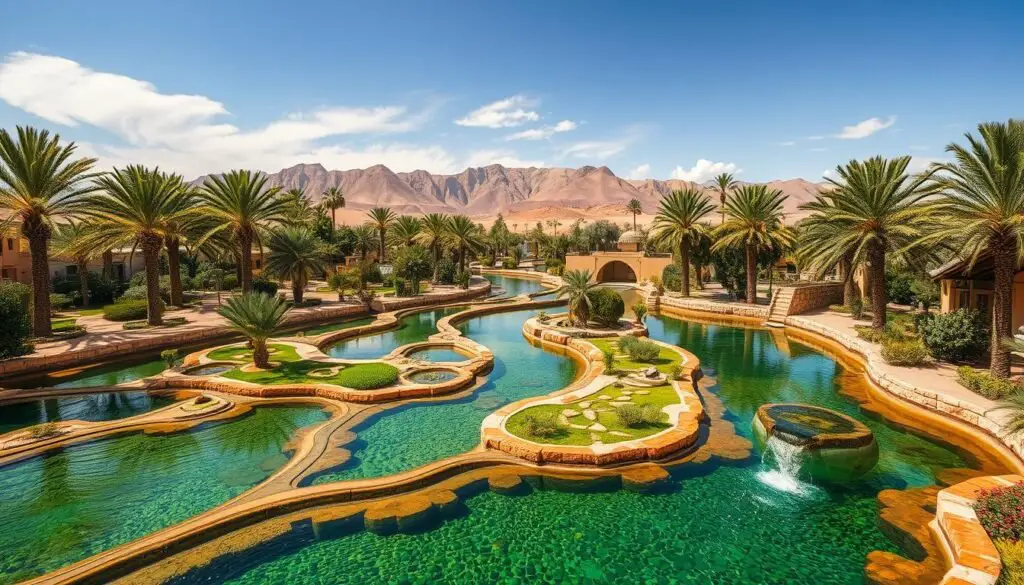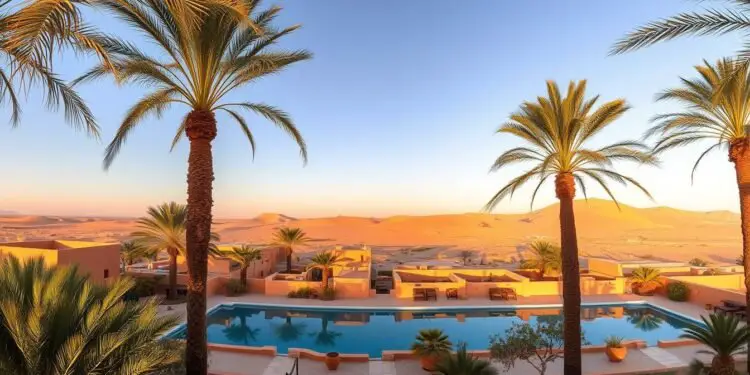Have you ever wondered where to find an untouched paradise blending ancient history with breathtaking landscapes? Nestled in Morocco’s Western Desert, the Dakhla Oasis offers a rare escape from crowded tourist spots. With over 13,000 years of continuous human habitation, this region is a living museum of Berber and Saharan heritage.
Stretching 80km long and 25km wide, this oasis is home to 75,000 residents across picturesque villages. Unlike Morocco’s bustling imperial cities, it provides an authentic desert experience—where golden dunes meet vibrant culture. Recent UNESCO recognition efforts highlight its archaeological significance, making it a must-visit for history lovers.
Key Takeaways
- One of Morocco’s oldest inhabited regions with rich Berber traditions.
- Located 350km from Marrakech in the serene Western Desert.
- Offers a unique mix of adventure and cultural immersion.
- Features stunning landscapes, from salt flats to ancient ruins.
- Less crowded than popular cities, ideal for off-the-beaten-path travel.
Introduction to Dakhla Oasis
Few places blend harsh desert beauty with life-sustaining water sources as remarkably as this region. Spanning 2,000 km², its habitable area relies on the Nubian Aquifer, a fossil water system dating back millennia. Ancient khettara tunnels still channel this resource to date palms and olive groves today.

The Draa-Tafilalet basin shapes its geology, with limestone plateaus shielding the land. Summers scorch at 49.5°C (121°F), while winters plunge to -3.9°C (25°F). Yet, villages like Mut thrive, balancing modern clinics with traditional mud-brick homes.
Agriculture defines daily life here. Farmers grow barley and olives using methods unchanged over time. But desertification looms—a reminder of nature’s fragile balance in this arid wonder.
Exploring Dakhla Oasis’s Rich History
Step into a land where time stands still, revealing layers of civilization carved into the desert. This region’s past stretches from prehistoric hunters to gold-masked nobles, each era leaving behind tombs, temples, and artifacts that defy the harsh climate.
Ancient Roots: From Prehistoric Times to the Pharaohs
Long before pyramids rose, Neolithic tribes thrived here. Archaeologists found 12,000-year-old tools and rock art, proof of early survival. By 2550 BCE, the ancient Egyptian 6th dynasty established trade, leaving clay tablets at Ayn Asil’s palace.
The Roman and Islamic Influence
Romans transformed the landscape with temples like Deir el-Hagar, dedicated to Amun-Ra. Later, Islamic rulers built Qasr ad-Dakhla’s 12th-century minaret, blending vaulted architecture with desert resilience. Mud brick structures still stand, whispering of empires long gone.
Recent Archaeological Discoveries
In 2017, five Roman-era tombs surfaced at Bir esh-Shaghala. The 2021 Ptolemaic mummy finds, adorned with gold masks, stunned researchers. Ongoing digs at Amheida even uncovered Greek school texts, hinting at a bustling scholarly past.
Must-See Attractions in Dakhla Oasis
Uncover the hidden treasures of Morocco’s desert with these must-see attractions. From Roman ruins to natural springs, each site tells a story of resilience and beauty.
Deir el-Hagar: A Roman Temple in the Desert
Step into the 1st-century Deir el-Hagar temple, where sandstone reliefs depict Roman emperors as pharaohs. Dedicated to the god Seth, its carvings reveal a blend of Egyptian and Roman artistry.

Wander through the ruins surrounded by towering mud-brick walls. The site’s isolation adds to its mystique, offering a quiet glimpse into ancient worship.
Qasr ad-Dakhla: A Step Back in Time
Qasr’s 21m Ayyubid minaret dominates the skyline of this medieval town. Lose yourself in labyrinthine alleys lined with 4-story mud-brick compounds.
Visit the 17th-century Ethnographic Museum, housed in a former governor’s residence. Its exhibits showcase traditional crafts and local history.
Hot Springs and Natural Wonders
Rejuvenate in Bir Regina’s hot springs, where sulfur-rich waters bubble at 45°C (113°F). Surrounded by date palms, it’s a desert oasis in every sense.
Nearby, Camel Rock’s wind-sculpted sandstone formations make for striking photos. For adventurers, White Mountain’s fossil cliffs reveal prehistoric secrets.
Practical Travel Guide to Dakhla Oasis
Planning your journey to this desert paradise? Here’s everything you need to know. Whether you’re arriving by air or road, this travel guide covers the best routes, stays, and eats for a seamless adventure.
Getting There: Transportation Options
The nearest airport is in Errachidia, 200km away via the N12 highway. For a scenic way to travel, CTM buses run from Marrakech—a 10-hour ride through Ouarzazate.
Adventurers can opt for a 4WD route from Merzouga (5 hours) or the paved N9 highway. Both offer stunning desert views, but 4WD is best for off-road exploration.
Where to Stay and Eat
Choose between luxury eco-lodges like Xaluca Dakhla or a rustic mud-brick guesthouse. For a unique experience, try desert camping under starry skies.
Don’t miss the Friday markets in Tineida, where local people sell handmade crafts. For dinner, Tagine Dakhla serves stuffed camel meat—a regional specialty.
Winter (November–February) is the ideal time to visit. If exploring Gilf Kebir National Park, check permit requirements in advance.
Conclusion
For travelers seeking raw authenticity, Dakhla Oasis delivers unmatched experiences. Its blend of archaeological wonders and desert adventure sets it apart from commercialized Sahara tours. Here, Roman temples and hot springs coexist with thriving Berber traditions.
New luxury resorts enhance comfort, but the place retains its soul. Support local cooperatives to preserve its fragile ecosystem. This is a bucket-list spot for those who crave culture and history beyond guidebooks.
Ready to explore responsibly? Connect with the Dakhla Heritage Preservation Society to volunteer or learn more.
FAQ
What makes Dakhla Oasis unique compared to other desert towns?
The region stands out for its blend of ancient history, mud-brick architecture, and natural hot springs. Unlike busier tourist spots, it offers a peaceful retreat with well-preserved tombs and Roman-era temples.
How far is Dakhla from major cities in Morocco?
It’s roughly 550 km from Marrakech and 1,000 km from Casablanca. Travelers can reach it by car, bus, or domestic flights to nearby airports.
Are there guided tours available for historical sites like Deir el-Hagar?
Yes, local guides offer tours to key landmarks, including the Roman temple and 6th Dynasty tombs. Many provide insights into the area’s pharaonic and Islamic past.
What’s the best time of year to visit?
October to April is ideal, with mild daytime temperatures. Summers can be extremely hot, often exceeding 104°F (40°C).
Can visitors swim in the natural springs?
Absolutely! The hot springs near Qasr ad-Dakhla are safe for swimming, with mineral-rich waters believed to have therapeutic benefits.
Is the mud-brick architecture still in use today?
Yes, many buildings in the old town, including homes and the iconic minaret, are constructed using traditional mud-brick techniques passed down for centuries.
What should I pack for a trip to the Western Desert?
Bring lightweight, breathable clothing for daytime, warm layers for cool nights, sunscreen, a hat, and sturdy shoes for exploring rocky sites.




